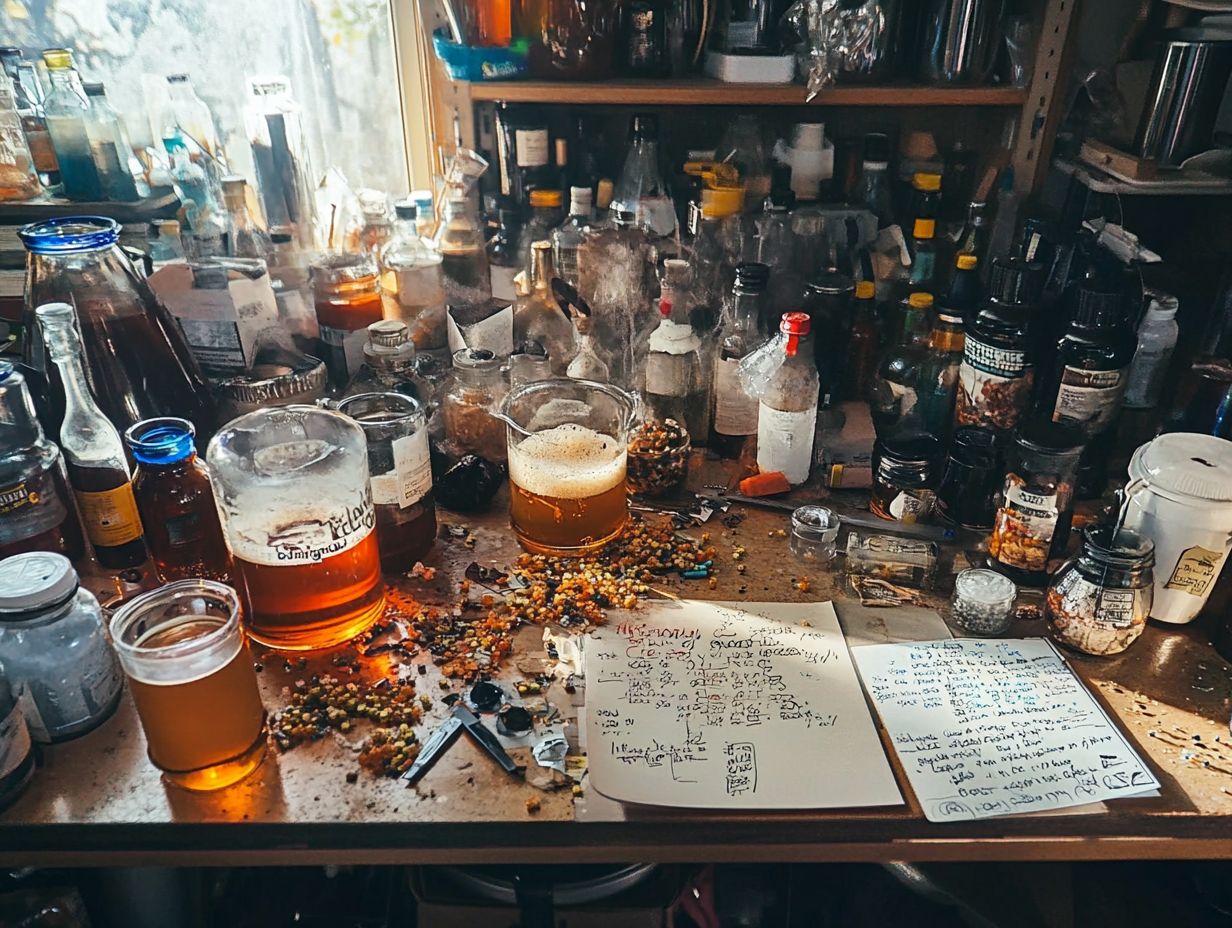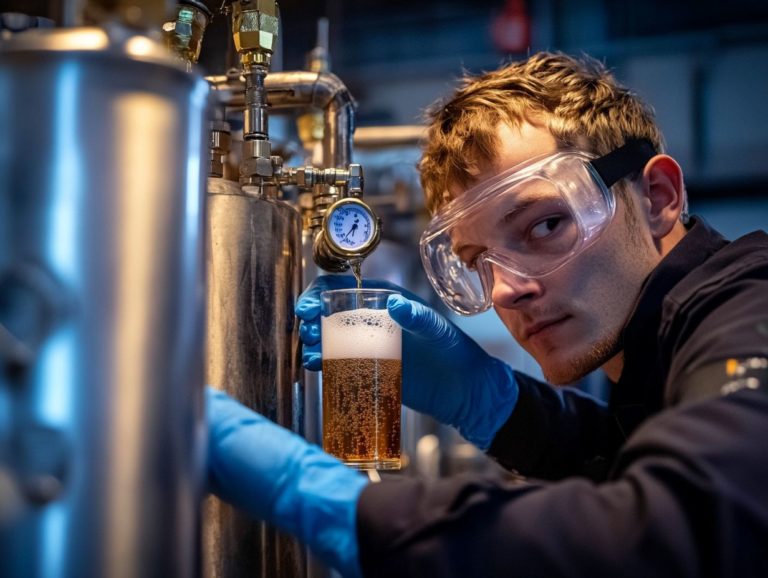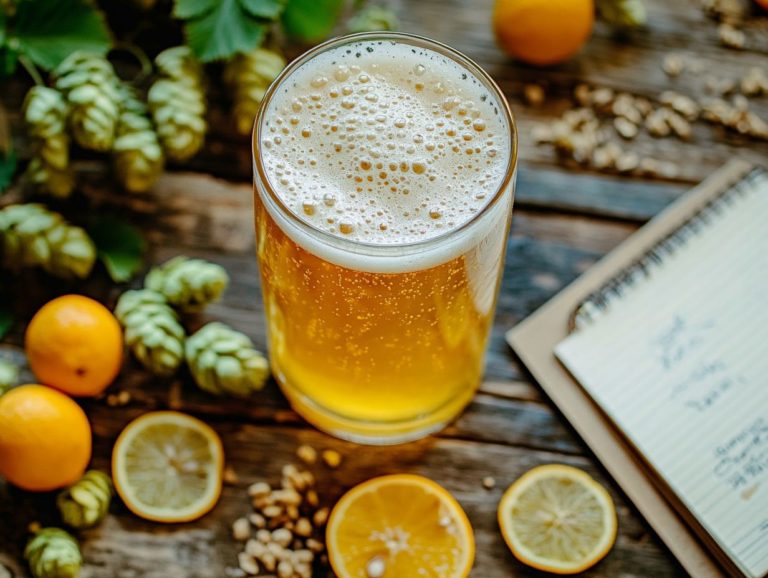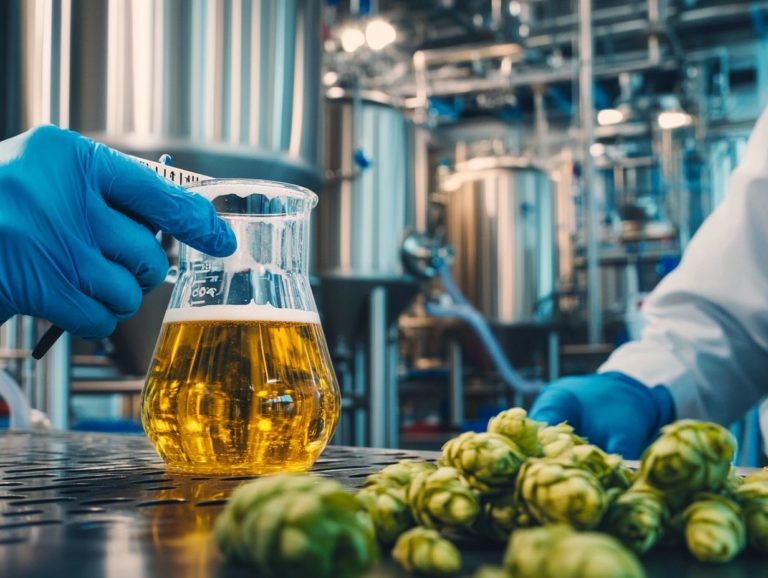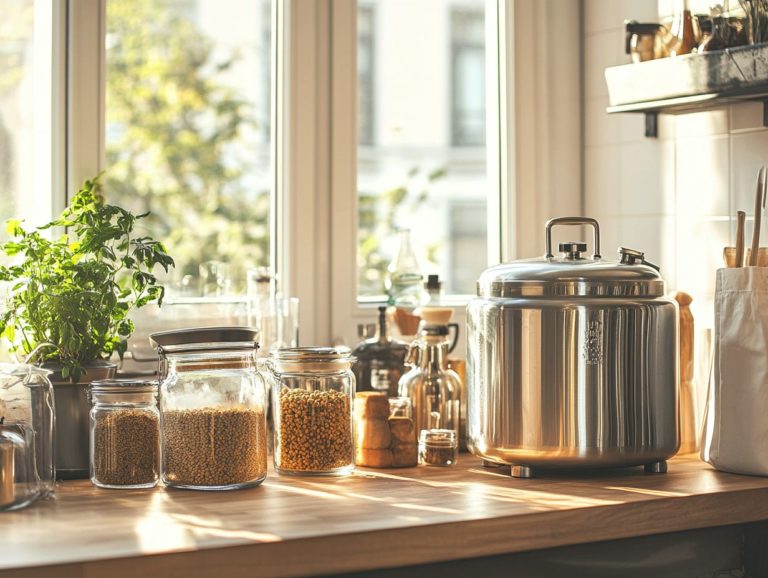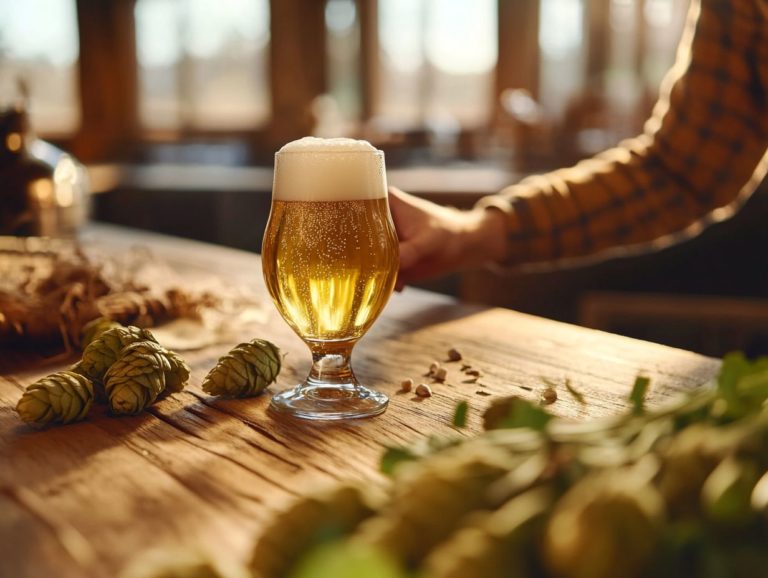Common Home Brewing Mistakes to Avoid
Home brewing, or homebrewing, can be a truly rewarding and enjoyable hobby, but it’s all too easy to stumble into mistakes that could spoil your brew.
You ll find that improper sanitizing properly and using subpar ingredients or low-quality water are common pitfalls that can lead to off-flavors, inconsistent alcohol content, and even contamination. This article shines a light on the key mistakes to avoid in homebrewing, their impact on the quality of your beer, and offers practical tips to help you brew the perfect batch every time.
Whether you’re just starting out or have been brewing for years, understanding these missteps can significantly elevate your brewing game.
Contents
- Key Takeaways:
- What Are the Common Mistakes in Home Brewing?
- 6. Not Cleaning Equipment Properly
- 7. Not Allowing Enough Time for Fermentation
- 8. Not Properly Carbonating the Beer
- Impact of Mistakes on Your Home-Brewed Beer Quality
- 3. Risk of Contamination
- 4. Poor Carbonation
- How Can These Mistakes Be Avoided?
- 1. Thoroughly Sanitize All Equipment
- 6. Clean Equipment Properly
- 7. Allow Enough Time for Fermentation
- 8. Properly Carbonate the Beer
- 9. Store Beer in Appropriate Conditions
- Frequently Asked Questions
- What are the most common home brewing mistakes to avoid?
- How can not properly sanitizing equipment affect the home brewing process?
- What are the consequences of using old or expired ingredients in home brewing?
- Why is it important to closely follow the recipe instructions when home brewing?
- What can happen if the fermentation process is not monitored carefully?
- How can poor water quality affect the home brewing process?
Key Takeaways:
What Are the Common Mistakes in Home Brewing?
Homebrewing is a true art form, yet many brewers inadvertently make critical mistakes that can compromise both their final product and overall brewing experience.
Failing to sanitize properly, for instance, paves the way for contamination, while relying on low-quality water can dramatically alter your beer’s taste. Additionally, issues like underpitching yeast, squeezing the grain, or mismeasuring ingredients can result in unwelcome off-flavors and inconsistent fermentation outcomes.
Recognizing these pitfalls is essential for both novice and seasoned brewers alike who aspire to create exceptional beers that showcase their creativity and dedication.
1. Not Sanitizing Properly
Not properly sanitizing your equipment is one of the gravest mistakes you can make as a homebrewer. It opens the door to potential contamination, jeopardizing hours of hard work and compromising the quality of your beer. This can happen by not cleaning properly or using outdated methods.
Proper sanitization is essential for ensuring that each batch of beer retains its intended flavor profile and aroma. You have access to a variety of effective methods, such as chemical sanitizers, heat sanitization, and even UV light options, all designed to eliminate unwanted microorganisms. Using tools like a wort chiller can also aid in cooling wort quickly, reducing contamination risks.
Commonly used tools like spray bottles, soaking containers, and immersion heaters can significantly enhance these methods, ensuring ample coverage. Remember, if even a tiny fraction of your equipment remains unsanitized, it can introduce off-flavors or spoilage, resulting in sour or vinegar-like notes in your final product. Cleaning gear thoroughly is essential.
For anyone passionate about brewing, maintaining impeccably clean gear is absolutely crucial for achieving a successful brewing process and letting your craft truly shine. This includes using a fermentation chamber to control the environment effectively.
2. Using Low-Quality Ingredients
Using low-quality or outdated ingredients can drastically compromise the flavor and quality of your homebrewed beer, resulting in unwanted off-flavors and aromas that are entirely avoidable. Always verify your extract and other ingredients are fresh.
In terms of brewing, the quality of your ingredients is everything, particularly with hops, malt, and yeast. Fresh hops infuse your beer with vibrant aromas and flavors, enhancing its overall profile, while stale hops can impart a musty taste that completely overshadows your intended brew character. Old ingredients are a recipe for disaster.
High-quality malt is essential, providing the sugars needed for fermentation and contributing rich, complex flavors. On the flip side, using aged or subpar malt can yield brews that are unpleasant to taste. Yeast deserves equal attention; fresh and active yeast guarantees a healthy fermentation process that leads to a clean finish and consistent carbonation. Consider creating a yeast starter for the best fermentation results.
Investing in premium ingredients can transform your brewing experience, resulting in refreshing beers that are not just delicious but also truly memorable.
3. Not Controlling Fermentation Temperature
Failing to control fermentation temperature can lead to serious consequences for yeast health and performance. This ultimately affects the quality and flavor profile of your beer. Using a wort chiller can help cool wort rapidly, which is crucial for proper yeast performance.
As yeast is a living organism, its behavior shifts based on the temperature of its environment. If not managed properly, this may cause off-flavors or incomplete fermentation. Temperature fluctuations can place stress on the yeast, leading to stalled fermentation or an overproduction of unwanted byproducts such as fusel alcohols (which are undesirable alcohol compounds that can affect flavor) and esters.
To avoid these pitfalls, it s crucial to maintain optimal fermentation temperatures, which typically range from 60-75 F for ales and 45-55 F for lagers. Utilizing fermentation chambers or temperature control wraps will help create a stable environment for your yeast. Regularly monitoring the temperature with precise thermometers allows you to promptly correct any deviations, ensuring yeast vitality and resulting in a balanced, flavorful brew. Consider adding flavors judiciously to enhance your beer.
4. Not Measuring Ingredients Accurately
Not measuring ingredients accurately is a mistake you ll want to avoid, as it can lead to inconsistent results that impact everything from the final taste of your beer to its alcohol content. Inaccurate measurements can also result in a boil-over, creating a mess and wasting precious resources.
Precision is the name of the game in brewing. Employing tools like brewing scales and hydrometers can dramatically influence the outcome of your product. For instance, if you overlook the details while measuring grains or hops, you might face a boil-over, which not only creates a mess but also wastes valuable ingredients. An inaccurate gravity reading from a hydrometer may lead you to under-carbonate your beer, resulting in a flat, uninspired drink. Always use a refractometer for precise measurements.
These tools not only help ensure that your brewing process flows seamlessly but also enable you to replicate successful batches and refine your technique over time. Investing in precision will take your brewing to the next level!
5. Not Following the Recipe
Not following the recipe can lead to unforeseen complications during the brewing process, resulting in a beer that falls short of the desired flavors and characteristics.
Every ingredient you choose plays a pivotal role in shaping the final product. For example, the type and amount of hops you select will determine not only the bitterness but also the alluring aroma. Your choice of malt influences the sweetness and body of the beer. Experimenting with adding flavors can give unique characteristics to your brew.
If you skip a crucial step, such as allowing for proper fermentation time, you might end up with a brew that is overly sour or not fully developed. This teaches you the hard way about the virtues of patience and precision. Not aerating properly can also lead to incomplete fermentation.
Even a simple miscalculation, like adding too much sugar for carbonation, can lead to exploding bottles and a cleanup job that feels never-ending.
By adhering strictly to the recipe, you re not just crafting consistent and enjoyable beer; you re also sparing yourself the headache of painful lessons learned through trial and error.
6. Not Cleaning Equipment Properly
Not cleaning your equipment properly is a critical oversight in homebrewing. This can lead to contamination and spoilage of your beer, compromising its quality and flavor.
For any homebrewer aspiring to craft exceptional beer, ensuring that all brewing tools and equipment are meticulously cleaned after each use is paramount. Simple yet effective methods like using hot water, soft sponges, and cleaning solutions can significantly reduce the risk of undesirable organisms infiltrating your brewing process. Failure to clean properly can lead to oxidized beer, impacting flavor.
Tools such as fermenters, bottles, and even airlocks can harbor residual residues that not only affect taste but also promote off-flavors and unwanted aromas. By adopting a thorough cleaning regimen, you elevate the taste of your creations while safeguarding against costly mistakes that can arise from neglect. Additionally, not cleaning properly can impact the brewing process during bottling or starting siphon with the mouth, exposing beer to contaminants.
This fundamental practice shapes your overall brewing experience, underscoring the importance of hygiene in every carefully crafted batch.
7. Not Allowing Enough Time for Fermentation

Failing to allocate enough time for fermentation can leave you with unfinished beer, resulting in undesirable flavors and potentially hazardous conditions if you bottle too soon.
Fermentation isn t just a waiting game; it s a meticulous process that demands your attention and care. Each yeast strain operates on its own timeline, and understanding this can greatly elevate the final product. Using a wort aerator (a tool to introduce oxygen into the wort) can also help ensure proper yeast health.
Keep an eye on your yeast health! It s crucial for the perfect brew. If the yeast cells become stressed or die off prematurely, your beer may miss the mark on intended flavors or, worse, develop off-flavors that undo all the hard work you’ve put into brewing. Rushing to bottle can lead to carbon dioxide (CO2) buildup, which can cause overly carbonated or even bursting bottles. Flavors may not reach their full potential, leaving the beer tasting flat or incomplete. Always use a wort chiller for cooling wort quickly to maintain yeast integrity.
Investing patience during this crucial phase will ultimately pay off in both quality and enjoyment.
8. Not Properly Carbonating the Beer
Neglecting proper carbonation when brewing beer can result in a flat and lackluster beverage, ultimately detracting from the overall drinking experience. Using the correct amount of priming sugar is crucial to avoid these issues.
When you overlook the carbonation stage, your beer might miss that delightful effervescence that heightens the aroma and adds a vibrant mouthfeel. This vital step involves the careful incorporation of priming sugar, which acts as the key catalyst for carbonation. It’s like brewing with the precision of an advanced recipe, avoiding shortcuts that can lead to disappointing results.
By introducing just the right amount of sugar before bottling, you initiate a controlled fermentation process within the sealed container, generating carbon dioxide (CO2) that dissolves into the beer. However, caution is crucial; too much sugar can lead to over-carbonation, resulting in excessive foaming and an unpleasant flavor profile, whereas too little sugar may render your beer lifeless and flat. Keeping good notes on your process can help avoid such pitfalls.
To achieve the ideal carbonation levels, it’s essential to accurately calculate the appropriate amount of priming sugar based on your batch size and desired carbonation style. Allowing sufficient time for the carbonation process to unfold before savoring your creation is key to enjoying the finished product at its best.
9. Not Storing Beer Properly: Learning from Mistakes
Failing to store beer properly can lead to spoilage and a noticeable decline in quality, which directly impacts the flavors and aromas that you ve worked so hard to achieve. Learning from mistakes is crucial in this aspect of homebrewing.
To ensure you savor the best drinking experience, it s essential to consider the optimal storage conditions. Ideally, you should keep your beer in a cool, dark place, maintaining a temperature range of 45 to 55 F for most styles. Excessive heat can introduce off-flavors that no one wants to taste.
Protecting your beer from light exposure, especially UV light, is crucial to prevent a bad smell that can ruin it. If you find yourself with an undersized fermenter, be extra cautious with your storage conditions.
When you re homebrewing, efficiently cooling the liquid before fermentation is a vital step that minimizes the risk of contamination and significantly enhances the overall stability of your brew. Utilizing wort aerators can also optimize this process.
Proper cooling not only lays the groundwork for exceptional fermentation but also plays a key role in your beer’s longevity. Storing the finished product under the right conditions will greatly enhance your enjoyment, allowing you to maintain its intended taste profile for extended periods.
Consider the advice from seasoned brewers on forums like HomeBrewTalk for additional tips. Ready to take your brewing skills to the next level?
Impact of Mistakes on Your Home-Brewed Beer Quality
Mistakes in the homebrewing process can profoundly impact the quality of your final beer. These missteps may result in undesirable off-flavors, inconsistent alcohol content, and even contamination that compromises the safety of your brew. Conducting a water test can help identify potential issues early on.
It s essential to approach each step with care to ensure that your efforts yield a delightful and enjoyable result.
1. Off-Flavors and Aromas
Don t let off-flavors ruin your beer! Off-flavors and aromas in your home-brewed beer can stem from a variety of mistakes, leading to unpleasant tasting experiences that might even discourage the most passionate beer aficionados. This is a common topic on Brew Cabin, where experts like Matt Giovanisci provide guidance.
These undesirable traits often arise from fermentation issues, such as incomplete fermentation, where yeast may produce off-flavors like diacetyl, giving your brew a buttery taste, or iodine, which can be linked to certain grain problems. Malt contamination, covering liquid before fermentation, or improper storage of your ingredients can further compound these issues.
To avoid these common pitfalls, you should diligently monitor fermentation temperatures, making sure they stay within the optimal range for yeast activity, and always opt for fresh, high-quality ingredients.
Additionally, thoroughly cleaning and sanitizing your equipment can significantly reduce the risk of unwanted microorganisms, leading to a marked improvement in the overall flavor profile of your brew.
2. Inconsistent Alcohol Content
Inconsistent alcohol content in your home-brewed beer often arises from fermentation errors or poor yeast health management, resulting in unpredictable and unsatisfying outcomes. These inconsistencies stem not just from your choice of yeast, but also from key fermentation parameters like temperature and timing, both of which are pivotal in the fermentation process.
For example, maintaining an optimal fermentation temperature ensures that your yeast remains active and healthy, allowing it to efficiently convert sugars into alcohol. Utilizing suitable yeast starters can further enhance the fermentation process by providing a robust yeast population that can adeptly handle varying sugar levels.
This meticulous approach can profoundly impact the final alcohol content, which is central to your overall enjoyment of the beer. Variations in alcohol levels influence not only the flavor profile and mouthfeel but also the drinkability of your brew. Some enthusiasts may prefer higher alcohol beers for a bolder taste, while others might lean toward lighter options for a more refreshing experience.
3. Risk of Contamination
The risk of contamination is a serious concern for homebrewers, as it can jeopardize the safety and quality of beer, leading to spoilage and potential health hazards. Remember, even unfiltered wort can be a source of contamination if not handled properly.
Understanding that contamination can happen at various stages of the brewing process, from selecting initial ingredients to the bottling phase, is crucial for anyone eager to perfect their craft. One common issue arises from improper sanitization; if equipment and surfaces aren t cleaned thoroughly, unwanted microorganisms can thrive. During fermentation, exposure to air can introduce wild yeasts or bacteria, which can negatively affect your final product. To avoid such issues, consider advice from experts like Mr. Whipple on sanitization techniques.
To mitigate these risks, you should establish a rigorous cleaning routine, use food-grade sanitizers, and ensure a controlled fermentation environment. Incorporating practices like using airlocks during fermentation and maintaining the proper temperature can further enhance protection against contamination, ensuring a more successful and enjoyable brewing experience.
4. Poor Carbonation
Poor carbonation can significantly affect the mouthfeel and overall enjoyment of home-brewed beer, often caused by mistakes during the bottling process or improper use of priming sugar. Avoiding unrealistic expectations during this stage can help maintain realistic goals for your brew.
When carbonation levels fall short, you end up with a flat beer that lacks the delightful effervescence many enthusiasts crave. This problem can arise from various factors, including inaccurate measurements of priming sugar, insufficient fermentation time, or even temperature fluctuations during conditioning. Planning your brew day meticulously can help prevent these issues.
To achieve optimal carbonation, carefully measure priming sugar based on the specific gravity (a measure of the density of your beer compared to water) of your beer and maintain a stable fermentation environment. Bottling at the right temperature and allowing ample time for natural carbonation to develop will elevate the quality of your brew.
Understanding these guidelines is crucial for attaining that perfect balance of fizz and flavor in every bottle you create.
How Can These Mistakes Be Avoided?
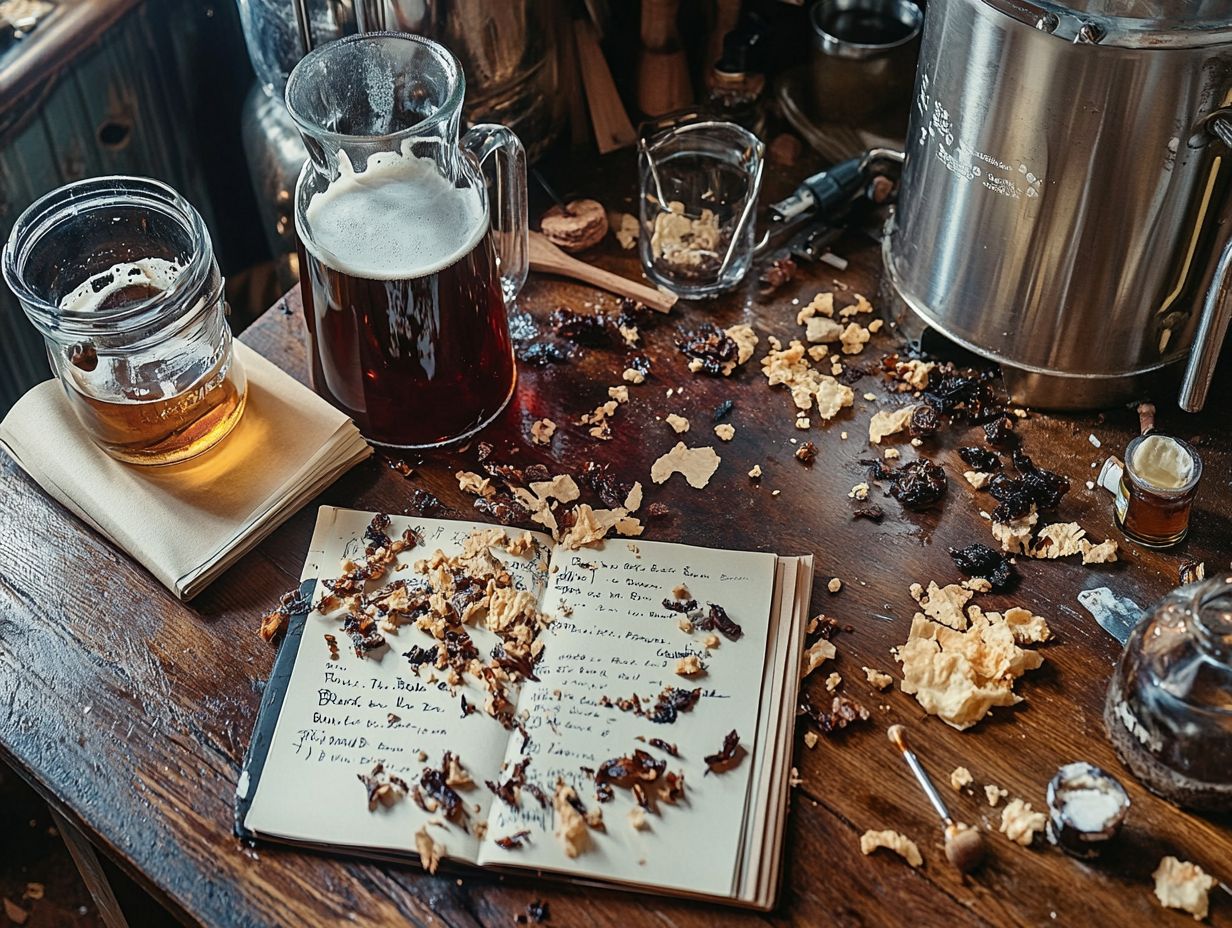
Want to master homebrewing? Avoid these common mistakes for the finest quality beer! You can elevate your brewing game by embracing best practices at every stage of the process. Follow advice from experienced brewers like Owen and take inspiration from brewing communities such as Bohemia.
1. Thoroughly Sanitize All Equipment
Thoroughly sanitizing all your equipment is the most effective way to prevent contamination and ensure the quality of your homebrewed beer. Just like characters in Adventure Time meticulously prepare for their quests, you must prepare your equipment diligently.
You have a variety of sanitization methods at your disposal to achieve this crucial step in the brewing process. For example, chemical sanitizers, like iodine-based solutions or chlorine-free bleach, come highly recommended for their efficacy in eliminating bacteria and other microorganisms.
Another method you might consider is using heat; boiling water is a superb way to sanitize your tools. Just remember to adhere to best practices make sure all surfaces are clean before sanitization and allow the sanitizer sufficient contact time to work its magic. Following these measures can help you avoid that metaphorical cliff of contamination.
If you’re looking to streamline your workflow while upholding a high standard of hygiene, utilizing no-rinse sanitizers can make the process even more efficient for you as a homebrewer.
Ready to brew your best beer yet? Start implementing these tips today!
2. Use High-Quality Ingredients
Using high-quality, fresh ingredients is paramount for crafting exceptional homebrew. They profoundly impact the flavor, aroma, and overall quality of your beer.
To achieve this, prioritize sourcing ingredients from reputable suppliers who can verify their freshness and origin. When selecting hops, seek out fragrant, vibrant green cones that feel slightly sticky to the touch. These characteristics typically indicate high oil content, which significantly enhances aroma and flavor.
For malt, ensure it boasts a sweet, grainy scent. Check for uniformity in size and color, as these traits suggest superior quality. And let’s not forget about yeast the heart of fermentation! Handle it with care; always check expiration dates and storage conditions to ensure viability. A healthy yeast culture is essential for robust fermentation.
By conducting thorough research and being meticulous in your selection of these components, you can significantly elevate your brewing experience.
3. Monitor and Control Fermentation Temperature
Control the fermentation temperature to ensure yeast health and achieve a successful fermentation process. By maintaining a stable environment, you can optimize yeast activity, which is essential for producing consistent flavor profiles and desirable aromas.
Utilizing fermentation chambers and reliable temperature control devices, such as digital thermostats or heating mats, enables precise adjustments that mitigate the risks associated with temperature fluctuations. When temperatures unexpectedly rise or fall, your yeast can become stressed, resulting in off-flavors and unpredictable outcomes.
Understanding this dynamic allows you to make informed decisions, enabling you to craft high-quality beer that aligns with your expectations while successfully navigating the complexities of fermentation. For more tips, visit Brew Cabin, a fantastic resource for all things brewing!
4. Measure Ingredients Accurately
Accurate measurement of ingredients is essential for achieving consistency and ensuring that the intended flavors and qualities of your beer come to life.
Using brewing scales can be a game-changer! They offer precise readings that enable you to weigh hops, malt, and other ingredients with meticulous attention. Even a minor discrepancy in the quantity of hops can drastically alter the bitterness and aroma of your final brew, ultimately affecting the entire tasting experience.
Accurate measurement goes beyond just flavor it ensures that fermentation and carbonation levels are spot on, which is vital for maintaining the integrity of your beverage. By utilizing tools like digital scales and refractometers, you can measure not only weight but also the specific gravity (the density of the liquid compared to water), fine-tuning the brewing process to perfection.
This level of detail can lead to extraordinary enhancements in flavor, texture, and aroma, significantly elevating the quality of your beer.
5. Follow the Recipe Carefully
Following the recipe is the key to brewing success! It ensures that every necessary step is taken to achieve the beer profile you desire.
Each ingredient you choose plays a pivotal role in the final product, influencing taste, aroma, and clarity. Deviating from your established brewing guidelines risks introducing unexpected flavors or, worse yet, spoilage, which can tarnish an otherwise commendable effort.
For those venturing into brewing, recognize that modifications should be handled with care. A great approach is to maintain a detailed brewing journal, allowing you to meticulously track any adjustments you make and their effects. This practice not only aids in refining your techniques but also preserves the integrity of the recipe’s core principles.
While experimentation can lead to innovative brews, remember that the fundamental balance of ingredients should remain intact to ensure the essence of the original recipe is preserved. Don t miss out on trying that new ingredient!
6. Clean Equipment Properly
Properly cleaning your brewing equipment is crucial for preserving the quality of your beer and preventing any potential contamination throughout the brewing process.
The significance of this cannot be overstated; even the tiniest residue left behind can negatively impact the flavor and aroma of your final product.
Your cleaning routine should encompass a variety of tools, including fermenters, kettles, and siphoning equipment. It s best to use hot water combined with an appropriate cleaning agent, such as non-toxic brewing cleaners or enzyme-based solutions, to effectively break down organic materials and sanitize surfaces.
Take the time to scrub every part, especially those that come into direct contact with your beer, to ensure complete removal of any lingering residue.
After you ve rinsed thoroughly, air drying the equipment is essential to prevent bacteria growth. This meticulous approach reinforces the importance of cleanliness in achieving that perfect brew you strive for.
7. Allow Enough Time for Fermentation
Allowing ample time for fermentation is essential in cultivating the rich flavors and unique characteristics of your beer.
Rushing this crucial process can lead to outcomes that are either unfinished or simply undesirable.
Understanding the fermentation timeline is just as important, often stretching across several days to weeks, depending on the yeast you choose and the specific recipe you re following.
During this phase, practicing patience is key, as the true magic of brewing unfolds slowly and deliberately.
You can monitor fermentation by observing the activity in the airlock; the bubbling you see indicates the release of carbon dioxide and is a sign that things are progressing nicely.
If you notice a layer of yeast sediment forming at the bottom of your fermenter, consider that a promising sign.
Another great indicator of successful fermentation is when you achieve consistent gravity readings over a few days with a hydrometer, which confirms that fermentation is complete.
Each of these signs serves as a comforting reminder that the flavors you ve worked so hard to develop are coming together beautifully.
8. Properly Carbonate the Beer
Want to ensure your beer is as delightful as it can be? Proper carbonation is key!
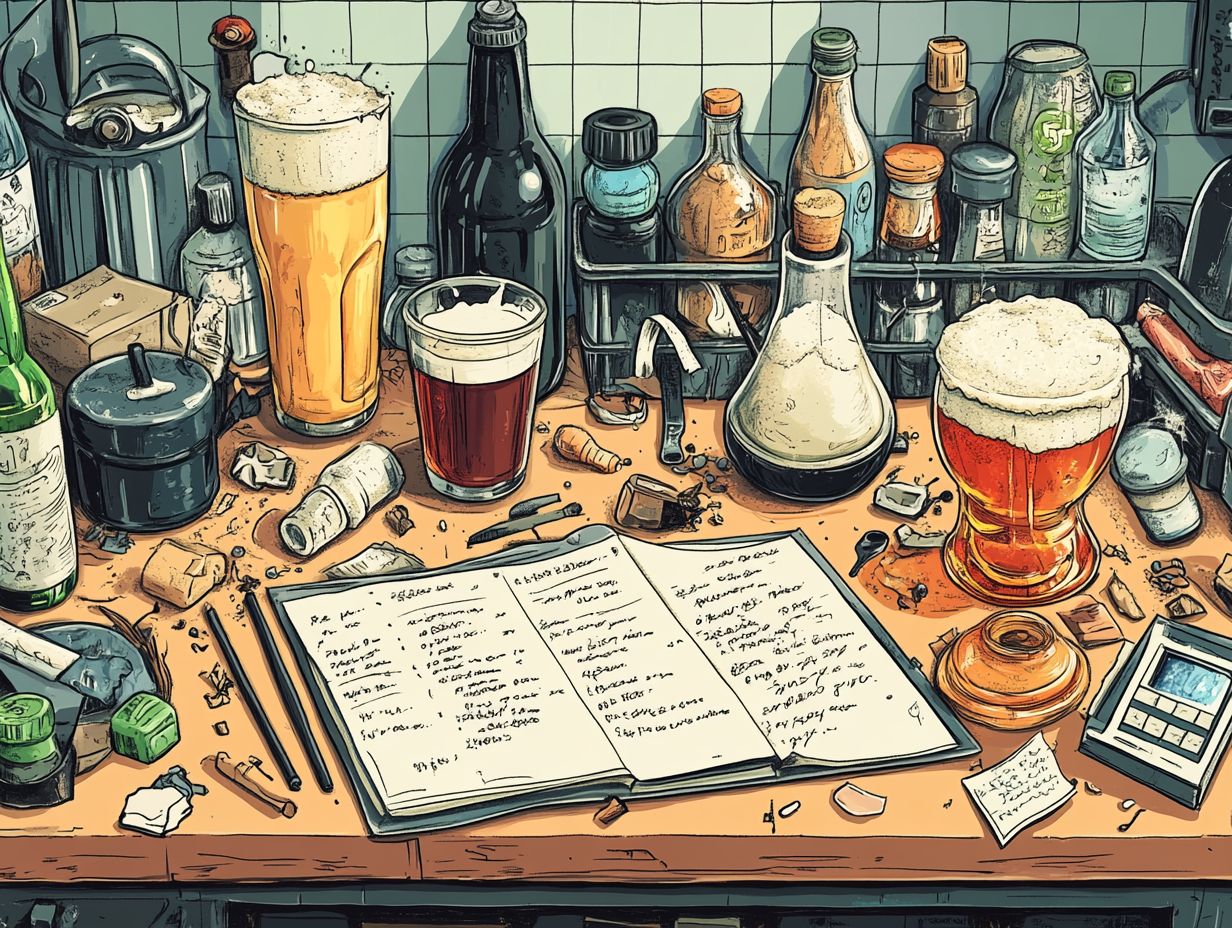
Properly carbonating your beer is crucial for enhancing the mouthfeel and overall enjoyment of your brew, and it all starts with accurate priming sugar calculations.
The carbonation process involves dissolving sugar in the beer, which the yeast ferments to create carbon dioxide.
To get the priming sugar just right, you ll want to use a formula that considers the beer s temperature and your desired carbonation level, typically measured in volumes of CO2.
For instance, a higher carbonation level can impart a lively aroma and a crisp finish, making it especially appealing for lighter beer styles.
However, be cautious too much carbonation can lead to over-carbonation, which may negatively impact the flavor.
To achieve that perfect carbonation, ensure your bottles condition at a consistent temperature and avoid any unnecessary agitation.
This way, you can sidestep off-flavors and truly enjoy the full experience of your meticulously crafted beer.
9. Store Beer in Appropriate Conditions
Storing your beer in the right conditions is essential for preserving its quality and elevating your drinking experience.
Maintaining the ideal temperature is crucial; extreme heat can introduce off-flavors, while overly cold storage might mute the beer’s character.
For maximum enjoyment, home-brewed beer should ideally be kept between 45 F and 55 F. This temperature range allows the flavors to develop fully without sacrificing the integrity of your brew.
Minimizing exposure to light is equally important. Ultraviolet rays can spark chemical reactions that adversely affect the taste of your beer.
To prevent this, consider storing your bottles in dark places or using protective packaging to shield them from harmful light.
Humidity is another factor to keep in mind. Excessive moisture can lead to degraded labels and compromised seals, whereas too little humidity can dry out corks, allowing oxygen to invade and spoil your precious brew over time.
By paying attention to these details, you can ensure your beer remains in prime condition, ready for your enjoyment.
Frequently Asked Questions
What are the most common home brewing mistakes to avoid?
Common home brewing mistakes include:
- Not properly sanitizing equipment
- Using old or expired ingredients
- Not following the recipe instructions closely
These pitfalls can significantly impact the quality of your beer. Avoid them to ensure a better brewing experience!
How can not properly sanitizing equipment affect the home brewing process?
Not properly sanitizing equipment can introduce unwanted bacteria or other microorganisms into the beer. This can lead to bad tastes and affect the quality of the final product. As Mr. Whipple would say, “Cleanliness is next to godliness,” especially in brewing.
What are the consequences of using old or expired ingredients in home brewing?
Using old or expired ingredients can result in bad tastes or spoilage in the beer, making it undrinkable. It’s important to always use fresh and quality ingredients for the best results.
Why is it important to closely follow the recipe instructions when home brewing?
Home brewing is a science, and following the recipe instructions is crucial. It helps achieve the desired flavor, alcohol content, and consistency of the beer. Deviating from the recipe can result in an undesirable outcome.
What can happen if the fermentation process is not monitored carefully?
Fermentation is the process where yeast converts sugars into alcohol. If not monitored carefully, it can lead to under or over-fermentation, which can affect the flavor and carbonation of the beer. It’s important to regularly check the temperature and gravity of the beer during fermentation.
How can poor water quality affect the home brewing process?
Poor water quality can result in bad tastes and affect the overall flavor of the beer. It’s important to use filtered or distilled water for home brewing to ensure a clean and neutral base.
Avoid these common mistakes to brew the perfect beer at home! Start your brewing journey today with confidence!

